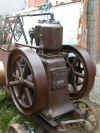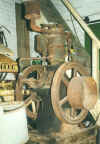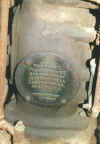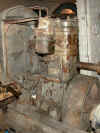(Überarbeitet
9 Juli 2000)
Ein Überblick von was Ich weltweit an Schrott nicht verweigern konnte ...

Leider
ist alles noch in Englische Sprache, entschuldige dafür, für die Übersetzung in
Deutsche Sprache habe Ich leider noch kein Zeit gefunden.
H.S.C.S
HSCS (Hofherr Schrantz Clayton Shuttleworth) was building tractors, but also engines, this is number 4128, built probably in about 1925.
The most recent type of Benz engine seems to have been
inspired by this design ?
Open crank, rotating magneto. Mechanically quite unusual. HSCS engines are quite
rare.
Lorenz
Lorenz war ein sehr erfolgreiche Fabrikant von Motoren. Die Firma wurde 1887 von Ignac Lorenz gegründet. Diese Motoren waren zur Zeit modern und zuverlässig, bis ungefähr Nummer 20000 blieben sie fast gleich … Halboffen (seitlich offen), Ausklinkregler, Magnet mit Schlaghebel, seitliche Nockenwelle. Rotguß Vergaser. Das Bild zeigt deutlich wie schön ein Lorenz aus etwa 1925 wird wenn restauriert.
Lorenz ZUM VERKAUFEN : jan_deklerck@hotmail.com
Lorenz 4HP no. 1796, built in about 1920. This engine is a quite early
Lorenz.
(most collected Lorenz engines have engine numbers over 10000)
A few characteristics give away it's old age :
carburetor on top of the cylinder, valves on one side, at an angle of 90 º to
each other, square foot on the fuel tank, a.s.o.
His twin is FOR SALE : jan_deklerck@hotmail.com
Identification plate and logo (on the cooling tank) for an old-style Lorenz motor,
approx 1925.
Some Lorenz engines have a coupling in the pulley, but this engine style is
rarely seen.
Contrary to the smaller engines, the bigger types remained fully open crank, but very few of these are known to survive.
The later engines were petrol-paraffin. Although these engines still very
much resemble their other brothers,
they can readily be recognized due to their modern style carburetor, volume
governing, and a fuel tank divided into 2 compartments, each with its own tap.
Restored, this becomes a surprisingly handsome engine, at a very affordable
price.
The bigger engines from that period were also half-open crank.
Later still, Lorenz started building diesel engines, four-stroke, but also
two-stroke. The latter resemble very much the Belgian Moes
engines.
Originales
Originales Originales
(Index)
Benz
Benz is the most wanted somewhat affordable Czech engine. Open
crank, hit-miss, magneto with striking lever, sideshaft.
Most collected Benz engines have engine nos over 2500.
The earliest Benz engines had low-tension ignition (rare, hardly affordable).
Somewhat later, the choice was offered between low- and high tension, the rest of the engine being identical (e.g. nr. 901, 5hp, high tension option). Because of this possible choice, the sparking plug was mounted in a exchangeable flange .
Still later, only high tension was available, doing away with the flange. It should also be noted that the steering front wheels are now situated under the cooling tank.At that time the engines could be had in 2 versions, light and heavy. For example, you will see the 4/5HPwith flywheels of 66cm diameter and a weight of approx 350kg, and with flywheels of 75cm diameter, bigger cylinder size, and a weight of approx 650 kg, but running at lower RPM. Later variations concern the valve mechanism, connecting rod lubrication, pressure lubrication for the piston, cast iron cover over the crankcase, a.s.o.
Benz FOR SALE : jan_deklerck@hotmail.com
The last design introduced by Benz was of a completely different design, smaller, and only about 200 have been built. (e.g. nr. 7278, 5-6 hp, approx 1936). This engine had the pressure lubrication for the piston, using a little pump topped by an oiler. Surprisingly, the engine was still open crank.
Kokora
Eduard Kokora in Prerau (Czech Republic) was building steam engines,
threshing sets, engines, and all kinds of implements : straw cutters, straw
elevators, horse gins, chaf blowers, plows, harrows, seeders, a.s.o.
This Kokora engine dates from approx 1915. It is a very characteristic Czech
threshing engine, a sole survivor of the type, 1500 kg for only 5hp !
The cooling tank is not original, probably some overheating problems were
experienced : the engine now has screen cooling and forced circulation.
Originally it had thermo-siphon natural circulation, as most Czech engines have.
The low tension ignition was also replaced
by high tension, possibly because that proved more reliable.
Klima
Klima (Tsjechië), approx 1925
Open crank, covered by a cast iron cover, hit-miss, magneto with striking lever.
Very massive, compact design. Klima is quite rare.
Klima FOR SALE : jan_deklerck@hotmail.com
Dobry
Dobry, approx 1930
A quite rare engine, as far as I know the only other Dobry is in a Czech museum.
Open crank, hit/miss, magneto with striking lever. A surprisingly simple, big
engine, very long connecting rod, equipped with a roof.
Slavia
Slavia was a very succesful company, with modern engines .
De older collected Slavia engines are big vertical petrol engines with side
valves.
They have volume speed regulation, and a high tension magneto with striking
lever.
These engines, dating from the end of the 1910's, are quite difficult to come
by.
The engine could be termed as a "Lister-lookalike", on an original
trolley with shapely cast iron wheels.
The forced cooling pumps the water over a cooling screen. (Claeys
had the same cooling sytem).
Slavia TE KOOP : jan_deklerck@hotmail.com
More recent engines are smaller and run at higher rpm.
Later Slavia also built diesel engines, mostly 2-stroke. They look very much like the Belgian Moes engines
An especially attractive feature of a Slavia engine is the delicate casting at the sides of the cooling screen : it displays the "Savia" name in elegant lettering.
Little (Josef Odstrcil)
"Little"
Josef Odstrcil,
45
cm Ø, ±150kg, ±1920 ![]()
![]()
![]()
![]()
Ein extrem seltene Motor, nur noch 2 Little Motoren sind bekannt (der zweite hat
Wasserkühlung).
Der Motor ist einen International Tom Thumb sehr ähnlich (sehe die Beschreibung
auf die "Motoren" Seite).
Vor den ersten Weltkrieg wurden eine Menge International Motoren in diesen Teil
Europas importiert, und weil sie sehr zuverlässig waren, darf es keinen
wundern, das eine kleine Firma wie Josef Odstrcil einen International nachbaute
(wie auch REMAR, eine andere Tschechische Firma, den Amanco Chore Boy
nachbaute).
Aber den "Little" war doch gegenüber den Tom Thumb um einiges
verbessert.
Zum Beispiel die Lagerung des Zwischenzahnrads zum Magnetantrieb war viel
stabiler, beim Tom Thumb ist diese sehr zerbrechlich.
jan_deklerck@hotmail.com (Index)
International famous
International Famous "Nonpareil" (USA), 1917
This type of engine is not a common sight, and even then, it is rarely equipped
with the huge low tension magneto this one is equipped with.
International Famous TE KOOP : jan_deklerck@hotmail.com
Claeys
Leon Claeys from Zedelghem, Belgium, was quite well known for
his very reliable engines, most of them being sold in portable form. The older
diesels diesels (1930's) in many cases found a job as a pure stationary engine,
de jlater, smaller diesels could only be bought for that purpose.
De older style engines (diesel, hot bulb crude oil, petrol) in many cases were
sold with a clutch in the pulley, an optional extra.
The photo shows a Claeys (Belgie) hot bulb engine seeing daylight again for
the first time since 30 years, somewhere near Antwerpen, the original owner
kisses it goodbye. A few weeks later the engine was first shown (not without all
kinds of minor problems) in Ardingly (UK).
Another few weeks later it ran in Marke (Belgium), at the Nuttin engine-show,
and in Lauwe (Belgium), where relatives from the original owner came to wonder
what granddads machine was like after return from oblivion …
Claeys hot bulb engines are very much sought after, especially by people from
Holland ....
The Home Page shows the engine being used, end of the 1930's.
A Claeys (Belgie) petrol engine of approx 1917.
Only very few Claeys petrol engines are know to survive.
Originales
Originales Originales
Originales
(Index)
La Fourmi
La Fourmi (Belgium), built 1899. Open crank town gas engine, low tension.
La Fourmi was built in Kortrijk, and is very collectable. About 15 La Fourmi
engines are known to exist.
This engine is the biggest surviving La Fourmi, the only one of its kind.
These bigger types of La Fourmi engines have a very characteristic volume
governing system, using a toothed lever, the regulator in function of the engine
speed then selects a tooth, so dictating the amount the valve opens.
Another unique engine is the La Fourmi "portable", fully original,
with a crop spraying waterpump, the drive of which is partly incorporated in the
engine castings.This engine has a rather classic hit-miss regulator, operating a
slide valve.
Ruston
Ruston (Engeland) PR size 2, approx 1935
Ruston is more known for their larger stationary engines, but this is a smaller
open crank petrol engine.
I plan to use the engine as a starting aid for a bigger Ruston HR4 stationary Diesel
of 1935, by means of a friction wheel in contact with the flywheel.
The Ruston HR4 is a typical stationary engine for industrial use, this one drove a flax mill. It wa sbought second hand to replace a Bollinckx steam engine. The photo shows my son Piet wondering if we will ever succeed in freeing the keys securing the flywheel. Eventually they came out. That was a relief, since the engine had to be brought out through a corridor only about 1m25 wide.
Jongere Ruston PB
TE KOOP
: jan_deklerck@hotmail.com
Originales
(Index)
Wichterle
Franz Wichterle founded his company in 1878.
The engine shown was built in approx 1913, in that year the company employed 1050
people.
Wichterle was then building steam engines, mainly portables, threshing machines,
and petrol engines.
At the turn of the century Wichterle had gained an impressive number of
medals at shows, in Czechoslovakia, but also in Russia and Paris.
Wichterle engines are quite rare, and quite probably this engine is the only one
of its type surviving.
This engine, and in fact almost all Wichterle engines (except the cheaper "high
speed" engines), are equipped with a clutch in the pulley.
The carburetor seems to complicated for a petrol engine, and since the air
intake is around the exhaust, one could think this is a paraffin engine. This is
not the case, it is a petrol engine, the period documentation describes this
system, boosting a very low petrol consumption..
Wichterle-Kovarik
Ergens midden de jaren '20 gingen de firma's Wichterle en Kovarik samen, en vormden zo de firma Wichterle-Kovarik, later afgekort tot WIKOV. De firma werd zeer succesvol, vooral door hun motor type "Robot", een zeer eenvoudige, goedkope, betrouwbare benzine-petroleum motor, waarvan er zeer veel gebouwd werden.
Mijn motor is waarschijnlijk het eerste gezamenlijk ontworpen motortype Wichterle-Kovaric. Het is het laatste type dat een typeplaat meekreeg, de latere types hadden geen typeplaat meer : alle informatie werd eenvoudigweg in grote letters op de motor geschilderd. In tegenstelling tot Robot-motoren (deze naam werd uiteindelijk bekender dan de firmanaam Wikov zelf), is een Wichterle-Kovaric motor zeldzaam. Mijn motor is in vrij slechte staat, met enkele ontbrekende onderdelen, maar daar mag een echte verzamelaar zich niet door laten tegenhouden, natuurlijk ... Een incomplete, iets jongere motor zal de nodige wisselstukken leveren.
Originele Info
Originele Info
(Index)
Mid 1920's the companies Wichterle and Kovarik merged, to become the company Wichterle-Kovarik (later shortened to WIKOV). The company was very successful, and became famous for their "Robot" engine, a very simple, affordable and reliable petrol-paraffin engine. Many of these were sold.
My motor is reputed to be the first type of engine designed jointly by Wichterle-Kovarik. It is the last type of engine to have a brass identification plate, the later engines had all information painted on the engines in fairly big lettering. Contrary to the Robot engines (this brand name eventually became better known than the company name Wikov), the Wichterle-Kovarik engine is quite rare. My motor is in a sorry state, with some parts missing, but a genuine collector should not be stopped by such minor problems, don't you think ?
Fairbanks-Morse
This will not be the first Fairbanks-Morse Z engine you see.
But this model was built during only 1 year: in 1918.
Very distinctive is the small Sumter low tension magneto built as one assembly
with the igniter.
Amanco
Amanco (Associated Manufacturers Company) needs no introduction, every show
displays several of them usually.
Low tension, hit-miss, open crank : a very attractive engine, both to the eyes
and to the ears !
At a shw, an Amanco Chore Boy was for sale, but everyone looked at it
suspiciously : it had no identification late, and although it looked like an
Amanco, several features were quite different. An Amanco copied ? (Quite a lot
of companies copied the Amanco design, for example Remar in Czechoslovakia did).
But this is an original Amanco, but a very early one : the magneto drive is
parallel to the crankshaft, and the water hopper is a separate casting, with a
rectangular (not oval) opening, with the edges rounded inwards. Built in 1912
probably. Since no one wanted the engine, it was a good buy. It better was,
because the crankshaft needed a lot of persuasion to assume its original shape
...
The engine was converted to high tension. I have the igniter for low tension,
but can anyone offer me a magneto ? Tall model, bronze body. A later style magneto
with zamak body might fit the bill eventually. Offers : jan_deklerck@hotmail.com.
Thanks in advance !
(Index)
Junkers
Junkers is mainly known for its two-stroke diesel engines. (To us, that is.
Militaria collectors will know Junkers as the builders of the frightening StuKa
aircraft in WW2, and plumbers nowadays are installing Junkers water boilers).
A Junkers engine uses, in 1 cylinder : 3 pistons, and 3 connecting rods. The
engine has no valves, but ports in the cylinder.
De lower piston (rises for compression) opens and closes the exhaust ports, and
is driven by 1 connecting rod.
De middle piston (comes down during compression) opens and closes the inlet
ports, and is driven by 2 log slender connecting rods.
De top piston is bolted to the middle one, and works in a part of the cylinder
that has a larger bore, closed by the cylinder head, and forming an air
compressor for the inlet air.
This type of engine was the first successful high speed diesel, dated early
1940's.
Not many Junkers engines are seen, but this type of engine was also built
by CLM in France (Compagnie Lilloise de Moteurs) using a Junkers license.
Quite a few CLM engines survive, in stationary form, or for vehicle propulsion,
an example being the Latil forest tractor..
CLM engines are recalcitrant starters, Junkers engine fire at once.
Moës
De earlier Moës engine were two stroke hot bulb crude oil engines, and are very collectionable.
The later engines look very much like the earlier ones, but are two-stroke diesels.





























